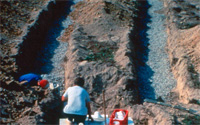Parts of a Septic Tank System
The most common type of septic system has four main parts:

- An exit pipe that carries wastewater from the home to the septic tank and vents noxious gases up and out of the house
- A buried, watertight septic tank made of concrete, fiberglass, or polyethylene, usually installed about 6 feet from a home
- The drainfield, which consists of one or more distributor boxes and a network of pipes buried in relatively shallow trenches that are usually packed with gravel or other filler
- Soil, full of bacteria that digest most contaminants before wastewater reaches groundwater.
How it Works
Household wastewater is flushed or washed through the exit pipe into the septic tank.
Heavy solids sink to the bottom. Over 24-48 hoursthe solids break down to form a sludge layer. Lighter floatable solids, such as grease, oils, and fats, collect at the top of the liquid in the tank to form a scum layer.
The bacteria that live in the septic tank constantly break down solid waste.The tank's fittings hold the scum and sludge from flowing out into the drainfield.
Liquid that is washed or flushed into the tank is known as effluent. In the tank, effluent is partially treated or "clarified" by bacteria. As the tank fills up, the liquid empties into the drainfield, where it is absorbed into the soil.
The liquid drains through the soil layers, where bacteria filter and digest contaminants. By the time the wastewater reaches groundwater, it is fully treated.
Additives
Companies that make and sell biological additives sometimes claim that their product restores a septic tank's bacterial balance, and that this is necessary as part of a routine monthly maintenance program. But bacteria already reside in human feces, so these additives usually are not necessary.
 Apply Online
Apply Online Find a Soil Classifier
Find a Soil Classifier